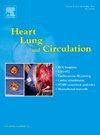Prognostic Implications of Machine Learning Algorithm–Supported Diagnostic Classification of Myocardial Injury Using the Fourth Universal Definition of Myocardial Infarction
IF 2.2
4区 医学
Q2 CARDIAC & CARDIOVASCULAR SYSTEMS
引用次数: 0
Abstract
Background
With widespread adoption of high-sensitivity troponin assays, more individuals with myocardial injury are now identified, with type 1 myocardial infarction (T1MI) being less common despite having the most well-established evidence base to inform care. This study assesses the temporal time course of cardiovascular events among various forms of myocardial injury.
Method
Consecutive hospital encounters were identified. Using the first episode of care during the sampling period, myocardial injury classifications (i.e., T1MI, acute injury/type 2 myocardial infarction [T2MI], chronic injury, and no injury) were established via two machine learning algorithms. The temporal time course of increased hazard for mortality, recurrent myocardial infarction, heart failure, and arrhythmia over 3 years were explored.
Results
There were 176,787 index episodes; 6.9% were classified as T1MI, 6.0% as acute injury/T2MI, and 26.7% as chronic injury. Although each classification was associated with an early increased risk of all-cause mortality compared with no injury (incidence rate ratio [IRR]<30 days: T1MI: 19.97 [95% confidence interval 12.50–32.69]; acute injury/T2MI: 26.51 [16.80–42.97]; chronic injury: 15.37 [10.22–23.95]), the instantaneous relative hazard for recurrent myocardial infarction was highest in those with initial T1MI (IRR<30 days: T1MI: 28.81 [22.75–36.76]; acute injury/T2MI: 10.23 [7.60–13.77]; chronic injury:5.54 [4.34–7.41]). In contrast, the instantaneous hazard for heart failure in those with initial acute injury/T2MI and chronic injury remained increased over long-term follow up unlike in T1MI (IRR1 3 yrs: T1MI: 5.52 [4.99–6.09]; acute injury/T2MI: 10.36 [9.51–11.30]; chronic injury:7.40 [6.90–7.94]).
Conclusions
The substantial and persistent rate of late cardiac events highlights the need to establish an evidence base for the therapeutic management of “non-T1MI” diagnostic classifications and suggests opportunity to improve late outcomes using existing and emerging therapies.
使用心肌梗死第四种通用定义的机器学习算法支持的心肌损伤诊断分类的预后意义。
背景:随着高灵敏度肌钙蛋白检测的广泛采用,越来越多的心肌损伤个体被发现,尽管有最完善的证据基础来告知护理,但1型心肌梗死(T1MI)并不常见。本研究评估了不同形式心肌损伤中心血管事件的时间过程。方法:确定连续医院就诊情况。使用采样期间的第一次护理,通过两种机器学习算法建立心肌损伤分类(即T1MI,急性损伤/ 2型心肌梗死[T2MI],慢性损伤和无损伤)。研究了3年内死亡率、复发性心肌梗死、心力衰竭和心律失常风险增加的时间过程。结果:共有176,787次指标发作;T1MI占6.9%,急性损伤/T2MI占6.0%,慢性损伤占26.7%。结论:晚期心脏事件的大量和持续发生率突出了建立“非t1mi”诊断分类治疗管理的证据基础的必要性,并提示了使用现有和新兴治疗方法改善晚期预后的机会。
本文章由计算机程序翻译,如有差异,请以英文原文为准。
求助全文
约1分钟内获得全文
求助全文
来源期刊

Heart, Lung and Circulation
CARDIAC & CARDIOVASCULAR SYSTEMS-
CiteScore
4.50
自引率
3.80%
发文量
912
审稿时长
11.9 weeks
期刊介绍:
Heart, Lung and Circulation publishes articles integrating clinical and research activities in the fields of basic cardiovascular science, clinical cardiology and cardiac surgery, with a focus on emerging issues in cardiovascular disease. The journal promotes multidisciplinary dialogue between cardiologists, cardiothoracic surgeons, cardio-pulmonary physicians and cardiovascular scientists.
 求助内容:
求助内容: 应助结果提醒方式:
应助结果提醒方式:


